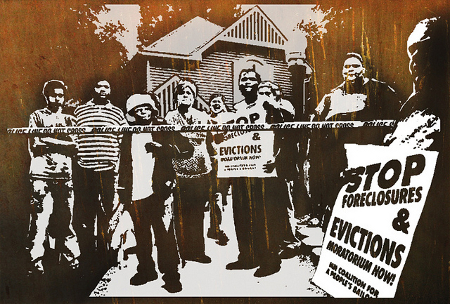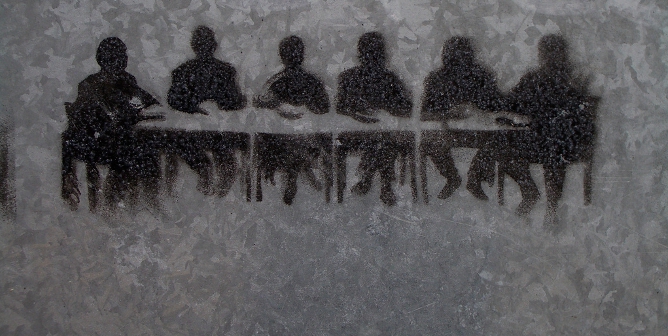 In the years since the Great Recession, falling foreclosure and unemployment rates have been used to measure the recovery from the economic crisis. Dara Z. Strolovitch rejects these supposedly objective indicators, arguing that these gauges ignore the enduring struggles of marginalized peoples. Furthermore, she challenges the notion of an economic “crisis” as reinforcing norms about who should be succeeding in the economy.
In the years since the Great Recession, falling foreclosure and unemployment rates have been used to measure the recovery from the economic crisis. Dara Z. Strolovitch rejects these supposedly objective indicators, arguing that these gauges ignore the enduring struggles of marginalized peoples. Furthermore, she challenges the notion of an economic “crisis” as reinforcing norms about who should be succeeding in the economy.
We typically take as given that the official and unofficial measures that political elites use to identify things like recessions and depressions are valid and objective indicators of economic crises (defined here as bad things that are framed as potential crossroads worthy of national attention or as emergencies that demand swift and decisive action to avert disaster). Examining the recent “Great Recession” and foreclosure crisis, however, highlights the ways in which these indicators can also serve to normalize the ongoing hard times faced by members of marginalized groups. In particular, it reveals the extent to which the very notion of “economic crisis” is a construct that relies on assumptions and practices that reflect, reproduce, and constitute prevailing attitudes and normative expectations about racialized and gendered labor and economic inequalities.
The Mortgage Meltdown, or When Does a Crisis Begin?
The constructedness of crisis is well-illustrated by the recent mortgage meltdown. In the fourth quarter of 2007, when the foreclosure crisis was widely recognized as being underway, the Mortgage Bankers Association estimated that 3.6 percent of all loans were seriously delinquent (that is, more than 90 days late) or in foreclosure, and that an additional 0.9 percent were entering foreclosure. Longer-term data demonstrate, however, that foreclosure rates among people of color, immigrants, low-income people, and female-headed households were at similar or higher levels well before the crisis was said to have begun. For example, a 2002 study commissioned by the U.S. Department of Housing and Urban Development found that the foreclosure rates for African American, American Indian, and Latino homeowners in 1996 were 4.8 percent, 4.4 percent, and 5.4 percent respectively, while rates were 2.9 percent for whites and 3.7 percent for Asian Americans.

As we might expect, the sharp increase in foreclosures that began in 2007 took a disproportionate toll on Africans Americans and Latinos, particularly on those who owned homes in majority-minority neighborhoods. Foreclosure rates during that period were higher and increased more steeply in census tracts in such neighborhoods (defined in the Joint Center for Housing Studies of Harvard University as census tracts in which over 50 percent of residents are members of racialized minorities) compared to mixed (defined in the report as census areas with 10–50 percent minority residents) and white (defined as less than 10 percent minority) tracts, even after controlling for average income. Moreover, rates in moderate-income majority-minority neighborhoods approached those in low-income white neighborhoods, and foreclosure rates in high-income minority neighborhoods exceeded rates in moderate-income white neighborhoods.
These disparities are themselves troubling reminders about the ways in which the material effects of crises can disproportionately harm members of marginalized groups. However, it is the indicators that were regarded as the harbingers of the crisis that are most germane. In particular, the high foreclosure rates documented among some groups as early as 1996 did not suffice to constitute a crisis. Rather, those disparities were construed as perhaps unfortunate, but unremarkable and predictable—even acceptable—results of patterns of racially-segregated housing, discrimination on the part of lenders, and lower average incomes among women and people of color. In other words, these ongoing economic problems and disparities were normalized, construed not as crises but as explanations and justifications for higher interest rates. It was not until foreclosure rates among middle-class white male-breadwinner households reached levels typical of those in minority communities and among female-headed households of all races and ethnicities that a foreclosure crisis was said to have begun.
From Mancession to Hecovery
If the example of the mortgage crisis illuminates the roles of persistent racialized and gendered inequalities in determining when crises begin, the case of the Great Recession illustrates that these inequalities also mark the criteria used to indicate that an economic crisis has ended and that we have returned to “normal” or even good economic times.
As many readers know, in December 2007, the American economy entered a recession that would eventually be marked by the highest unemployment rates of any recession since 1982. Soon after this “Great Recession” began, economists noted that unemployment among men seemed to be rising more quickly than unemployment among women. In May 2009, for example, male unemployment was reported to have reached 10.5 percent (up from 5 percent in 2007), while female unemployment was said to have increased to only 8 percent (from 4.8 percent in 2007).
It did not take long before political observers coined the phrase “mancession” to characterize this phenomenon, and several years of debate, speculation, and hand wringing about the gap’s origins, effects, and meaning ensued. Analysts pointed out that the disparity was, in part, a function of declines in industries such as construction, which remain dominated by men and which had been hard-hit by the collapse in the housing market. Others noted that while the unemployment rate for women was lower than the one for men, women’s rates of unemployment were not actually declining but remained, in fact, remarkably high. Women also to endure inequalities that had affected them long before the recession had begun: they remained concentrated in lower-paying service positions, average wages for white men remained higher than those for white women, and white men with high school diplomas continued to earn about as much as white women with college degrees.
While observers and analysts noted these disparities, there was scant acknowledgement of the fact that women’s lower rates of unemployment were at least in part an artifact of long-standing norms about women’s paid labor, whereby the proportion of women in the labor force was — and remains — far lower than the analogous of men. Lawrence Mishel and his colleagues estimate for example, that before the recession in 2007, 90.9 percent of men between the ages of 25 and 54 were in the labor force, compared to only 75.4 percent of women in this same group. So among all those in the paid labor force, it was true that a greater proportion of men were unemployed compared to the proportion of women. But even when the gap in male and female unemployment rates was at its peak, a greater proportion of American men than American women were employed. The absolute value of the number of men working also remained higher than the number of women, those men continued to earn more than their female counterparts, and they also continued to hold better jobs than more highly-educated women. Yet as in the case of the mortgage crisis, it was not these long-term structural inequities that constituted the situation as a crisis, rather, it was the suggestion that gendered norms were being challenged and gendered disparities possibly narrowing or reversing that was deemed the problem worthy of attention. In other words, the crisis was that white men were increasingly relegated to economic conditions previously and unceremoniously reserved for women and people of color.
Fast forward to September 19, 2010, when the Business Cycle Dating Committee of the National Bureau of Economic Research (NBER) met by conference call and determined that the “Great Recession” that had begun in December 2007 had ended in June 2009. While the NBER Committee was careful to note that its members “did not conclude that economic conditions since that month have been favorable or that the economy has returned to operating at normal capacity,” they did aver that the American economy was recovering from the longest recession since the Second World War.

Several months later, a March 2011 report from the Bureau of Labor Statistics (BLS) found that approximately 90 percent of the jobs that had been created in the preceding year, during the NBER-declared “recovery,” had gone to men. In other words, what the NBER had called a recovery had been, up to that point, what journalists came to call a “hecovery,” with benefits going primarily to men. Moreover, because cuts in public sector employment (which accounts for a disproportionate share of jobs held by women and African Americans) continued well after the recovery was said to have begun, by some indicators both women and people of color fared worse after the economic crisis of the Great Recession had “officially” ended.
Read in tandem, the NBER and BLS reports demonstrate how gendered norms and the expectation that women will always participate in the labor force at lower rates than men mark ideas about both the depth and gravity of the crisis of the Great Recession as well as the indicators that it was over. It is only in such a context that an upturn in which 90 percent of the jobs created went to (mostly white) men could be construed as a “recovery” from the Great Recession. And while the NBER was careful to issue the caveat that the economy had not “returned to operating at normal capacity,” even as, or perhaps because, women and people of color fared worse, the notion that the economy had entered a recovery was not questioned, and these racialized and gendered realities were at once subsumed, made invisible, and neutralized by this official end to crisis. Indeed, that the disproportionate benefits of the recovery went to white male workers was — and has long been — one of the conditions that, to borrow from Austin Sarat and Javier Lezaun, “make our sense of normalcy possible.”
This article is a version of the paper “Of Mancessions and Hecoveries: Race, Gender, and the Political Construction of Economic Crises and Recoveries,” published in Perspectives on Politics. The article will be open access until 21 December.
Please read our comments policy before commenting.
Note: This article gives the views of the authors, and not the position of USApp– American Politics and Policy, nor of the London School of Economics.
Shortened URL for this post: http://bit.ly/18wFE37
_________________________________
 Dara Z. Strolovitch – Princeton University
Dara Z. Strolovitch – Princeton University
Dara Z. Strolovitch is an associate professor of Gender and Sexuality Studies and affiliated faculty in the Department of Politics at Princeton University. She is a scholar of American politics whose interdisciplinary research explores the politics of marginalization, interest groups and social movements, and the intersecting politics of race, class, gender, and sexuality.She is the author of numerous articles and book chapters and of Affirmative Advocacy: Race, Class, and Gender in Interest Group Politics, (University of Chicago Press, 2007).






